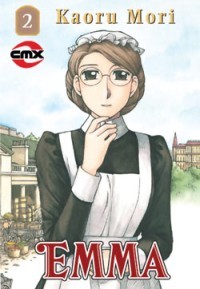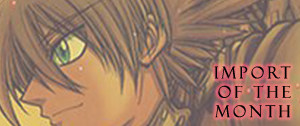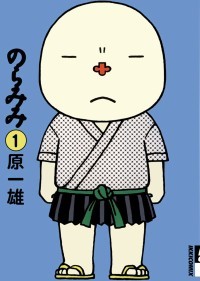RIGHT TURN ONLY!!
Invasion of the One-Word Titles
by Carlo Santos,

See, I knew there was something screwy about a comic convention trying to host an anime awards program.
But wow, some of the reactions were so vitriolic I wanted to start handing out fandom awards for Achievement in Acting Like Rabid Loons.
BASILISK

Vol. 3
(by Futaro Yamada and Masaki Segawa, Del Rey, $13.95)
FROM THE BACK COVER:
"Thanks to the machinations of Ieyasu Tokugawa, the age-old truce between the Kouga and the Iga clans is no more—and now a fight to the death will decide who will reign supreme. Oboro has blinded herself in order to avoid having to kill Gennosuke, her lover—and her rival. Meanwhile, Gennosuke has urged the Iga clan to join him on a journey to Sunpu to find out the real motives behind Ieyasu Tokugawa's orders to fight. But the Iga have other plans. The hirsute Nenki and the butterfly-wielding Hotarubi rush to assassinate Gennosuke, while Tenzen has sinister intentions for a defenseless Oboro. The epic battle of blood and betrayal continues!"
PROS:
Like any true elimination tournament, Basilisk's intensity ramps up as the number of participants goes down. This volume takes things from 5-on-7 to 4-on-4, and with fewer characters to keep track of, it's the most streamlined one yet. The fights are as graphic and heart-pounding as ever, and with the cast gradually being reduced to Gennosuke and Oboro's closest comrades, every battle becomes more personal. The journey of both clans to Sunpu adds the extra element of racing against time, a guaranteed tension-builder if there ever was one. Outlandish character designs make it easy to tell the fighters apart, and the nuanced shading and effects make a strong case for computer software as a genuine art tool and not just a gimmick. Sparse dialogue and visually striking layouts keep things moving at a rapid pace, and when it hits those pivotal fight scenes, the brutality and passion comes flying out all at once—just the way action fans like it.
CONS:
Now, about that Gennosuke-Oboro romantic angle ... it's really not working out. These two seem to spend more time talking about their love than actually being in love, although it's not entirely their fault, as this volume goes in a direction that keeps both clans from meeting directly. Still, the real tragedy for this tragic couple is that their story is far less interesting than the physical fights. This arc also tries to set up a couple of unrequited desires—the Iga clan's resident hothead Tenzen trying to take Oboro for his own; Kouga's sex-warrior Kagerou offering herself to Gennosuke—but they don't add any depth either. This is a series that works best in no-holds-barred battle mode, and any attempt at tricky plotting gets nowhere. Even the deception that's being set up in the last chapter should be an easy guess for readers. Come for the gripping action, but don't expect much else beyond that.
RTO!! RATING: B
EMMA

Vol. 2
(by Kaoru Mori, CMX, $9.99)
FROM THE BACK COVER:
"London's elite society places great importance on class differences, unlike William Jones. He regards Emma as a beautiful, charming young woman, and not merely a servant. After their first real date, things seem to be going in a positive direction for them. But the leisurely pace of the growing relationship between them ends suddenly when disaster strikes at home."
PROS:
How many England-related metaphors can I come up with to praise Emma? This volume goes down like a smooth Earl Grey tea—alluring to the senses but finishing with a hint of bitterness. The rumblings of class struggle that began in Volume 1 finally come to the surface, propelling the plot forward as William finds himself caught between the demands of family and his feelings for Emma. Graceful storytelling and gentle pacing continue to give the series its distinctive tone, even as the tension picks up with a tragedy halfway through and the resulting fallout that shows young love at its most desperate. Whether it's the sheen of upper-crust Victorian England or the harsh memories of Emma's destitute childhood, Mori knows exactly how to express it visually: few manga-ka have made such an art out of hatching, using repeated lines to create unique details. The result is a woodcut-like effect that brings out every prop, building, and character and pulls you right into the story.
CONS:
The first chapter in this volume, although endearing (William takes Emma out to the famous Crystal Palace), shows what can happen when cheesy romantic comedy elements sneak into an otherwise dignified work. Surely there are better ways to build a relationship than the old "getting locked in after closing time" trick. The latter half of the book also suffers from the same problem, with William and Emma trying to find each other around town and continually missing each other by minutes. It's a sweet way to show how much they care, perhaps, but it's also the kind of stuff that seems more appropriate for junky teen romances. How is it that even in a smartly executed series like this, the tension and development can still come from forcibly stupid character behavior and acts of miscommunication? Thank goodness for the unique setting, or it'd be just another silly he-said/she-said routine.
RTO!! RATING: B+
GACHA GACHA: THE NEXT REVOLUTION

Vol. 1
(by Hiroyuki Tamakoshi, Del Rey, $12.95)
FROM THE BACK COVER:
"A whole new Gacha Gacha story line begins! Akira Hatsushiba is just your typical, average high school kid . . . until a glitch in a Gacha Gacha video game changes his life forever. Now, every time Akira sneezes, his entire body undergoes a gender-bending switcheroo! That's right, Akira is always just an achoo away from getting in touch with his feminine side. But it's not all bad. Akira has had a crush on Yurika Sakuraba ever since he first laid eyes on her. He's always been too shy, but now that he can change into a girl, Akira finally has a chance to get close to Yurika. Being a girl certainly has its advantages!"
PROS:
The all-new, 18-and-up version of Gacha Gacha wastes no time in doing what it does best: pages upon pages of boobtastic fanservice. What may be surprising, though, is that it turns out to be more interesting than it has any right to be. Akira's mishaps as a girl with the mind of a boy say a lot about how the genders view each other at the pubescent level, perhaps none more telling (and amusing) than the scene where Akira discovers the joy of touching "herself." The growing friendship between girl-Akira and Yurika also has that unusual intimacy that is unique to female relationships—who needs traditional boy-girl action when you've got shades of yuri right here? This is a fun, fluffy read thanks to the clean panel layouts, which not only move the story briskly but also make sure to highlight the beauties in this series like any good cheesecake pin-up.
CONS:
I feel really sorry for the people who have to translate the dialogue. Akira's perverted thoughts are a given, but to see them expressed in words is just embarrassing—prepare to cringe for nuggets like "I can't believe it! I'm just inches away from Sakuraba's firm, curvaceous half-naked body" and "Boobies truly are amazing..." Yes, they are, now shut up. On a more macro level, the opening chapters of the new storyline also fall short: everything is just a recitation of fanservice-ready harem routines, including a beach trip, lingerie shopping, working out at the gym, and a school festival. The original Gacha Gacha clearly had the more outlandish storyline; this one sticks to boring old ideas. Even the comedy itself feels lacking—you'd expect Akira to be sneezing constantly and getting into all sorts of gender-switch embarrassments, but most of the time it's just girls hanging out with girls and showing off their body parts. Yawn.
RTO!! RATING: C+
LIFE

Vol. 3
(by Keiko Suenobu, Tokyopop, $9.99)
FROM THE BACK COVER:
"During a school trip, Ayumu continues to feel depressed—she cannot get the brutal image of Katsumi out of her head. In search of peaceful solitude, she walks towards a lake, only to come across Miki, who offers Ayumu some heartfelt advice. Now Ayumu is determined to take control of her emotions and become strong like Miki, so she returns to school hopeful and rejuvenated. But the harsh reality of her cruel surroundings sets in, and Ayumu's growing fury over her classmates' bullying is about to boil over..."
PROS:
The remarkable thing about Life is how it almost functions as a horror series—sure, it may look like an everyday school drama, but the stuff that happens here will freak you out more than any ghost story or monster invasion. Keiko Suenobu plays the psychological card at grandmaster level, revealing the devastating effects of cliques, bullying, and sexual harassment. Just when it seems like Ayumu's life couldn't get any worse ... oh, it gets worse, and the tension makes it hard to pull away. There are moments of incredible hope—the scene where Ayumu returns Miki's shoes deserves to be framed for sheer courage and inspiration—but also plenty of moments of incredible despair. Suenobu's expressive art is the key to this emotional outpouring, with striking layouts that stretch and squeeze to fit the weight of each scene, and powerful facial expressions that say more than any line of dialogue ever could.
CONS:
Perhaps, just once, it might be nice to let a little more "mellow" into the melodrama. With emotions constantly running high, this dark reflection of school life can feel like a ridiculous exaggeration, even though there are probably students right now going through situations just like this. Certain turns of plot also have an artificial air about them, moments that were set up just for dramatic effect without really making sense in the storyline—Ayumu's moonlight swim with Miki, beautiful as it is, is one such scene that seemingly comes out of nowhere. The same might be said for the shocking finale involving Ayumu and Katsumi, which, despite being a good lead-in to Volume 4, doesn't really click with the flow of previous events. (And Ayumu's mom suddenly showing up? Where on earth were you for two and a half volumes?) In matters of the heart, sometimes you have to let the logic slide.
RTO!! RATING: B+

Vol. 1
(by Housui Yamazaki, Dark Horse, $10.95)
FROM THE BACK COVER:
"Private detective Reiji Akiba has a theory about those weird coincidences we all encounter in life. They are actually encounters with the dead—their way of sending us a message. But you may not want to open such strange mail from beyond—not unless you can see the ghostly attachment, like Akiba can. And not unless you carry a tool that can kill what isn't alive, like Akiba's sanctified gun Kagutsuchi . . . digging a divine grave to lay to rest the evil dead!"
PROS:
If you liked Housui Yamazaki's precise linework in Kurosagi Corpse Delivery Service, get ready for more in the supernatural machinations of Mail, where he does both the art and the story. The sparse of expressiveness of his style fits the mood of the series perfectly, telling understated ghost stories that creep us out with just how down-to-earth they are. There is no outlandish spirit-hunting or sword-swinging here—the only concession to Shonen Jump-style sorcery is Akiba's spiritually powered gun—and when Yamazaki goes for the big scare, he pulls it off in grand fashion with grotesque imagery straight out of the J-horror tradition. The themes of the stories often skirt closer to urban legend than actual ghost story, and maybe that's why they work so well: a cursed apartment, a doomed pair of twins, a haunted car, a camera that catches what it shouldn't. The last story, however, might be the most effective one, revealing just what it takes to land a job as a spirit hunter.
CONS:
Looks like even a sophisticated, understated series can fall victim to Monster-of-the-Week syndrome. Akiba's spiritual dealings are compelling, but always boil down to him eventually tracking down the ghost and shooting it out, complete with a dorky catchphrase: "From X ... to Y ... to Z!" Alas, such moody stories ruined by such silly repetition. Fans of more bizarre, cultish supernaturalism might also be left cold by the dry, mainstream feel of these stories—well, they'd make great live-action adaptations, at least. The subject matter also stays firmly in the conventional; yes, they're the stuff that urban legends are made of, but for that same reason, they're all stories that we've heard before. It's almost too easy to come up with formulaic tales that prey on the basic human fear of life's conveniences turning against us. Artistically, Yamazaki may be a great craftsman, but he's definitely not much of an innovator.
RTO!! RATING: B

NORAMIMI

Vol. 1
(by Kazuo Hara, Shogakukan, ¥562)
FROM THE BACK COVER:
"This is a world where mascot characters make a living by 'freeloading' in households with children. At the Freeloader Referral Service, mascots are always busy coming in and out, being placed in new homes. But at one particular referral service, the 'Hello Kids 59th Branch,' the mascot named Noramimi does his freeloading right there. It's a pleasure to meet you."
PROS:
Sometimes it takes just one great idea. Noramimi is so awesome, it combines two: Japan's "cute culture" pushed to the corporate extreme, and mascot characters as a literal symbol of childhood innocence. Right from the first chapter, it hits you with a bittersweet story of growing up—a man in his twenties, hanging on to his mascot long past the due date (age 12), is having trouble letting go. From there it just gets more fascinating: a mother who has grown bitter over her own childhood loss, a poignant bus trip with mascots who are switching homes, even an unexpected reunion between a Hello Kids employee and his long-lost mascot. But lest this all congeal into a drippy sentimental goo, there's also enough comedy to go around, like with the lookalike bunnies, and of course, the perpetually-homeless mascot underdog, Noramimi himself. The simple gag-manga style artwork keeps things focused on the innocent tone, all the while telling stories of remarkable depth.
CONS:
As an episodic series, there are some parts that don't work as well as others. Sometimes the focus turns towards the human employees at the Hello Kids agency, and while they're certainly quirky in themselves, they just don't have the appeal of the actual mascots. In the couple of chapters that lack cute little animals running around and shaping the lives of children, the adventures of Noramimi and his co-workers turn out to be much more lackluster. The idea of selling packaged cuteness through a placement agency is funny, but the actual workplace where it happens is, well, exactly like a regular workplace. Boring. Also, the episodic nature leads to a certain monotony of theme—mascots and children come face to face with some sort of separation anxiety, sort out their feelings, and ultimately come to a poignant conclusion. It's good stuff, but with that kind of sentimentality floating around, probably best taken in small doses.
discuss this in the forum (14 posts) |